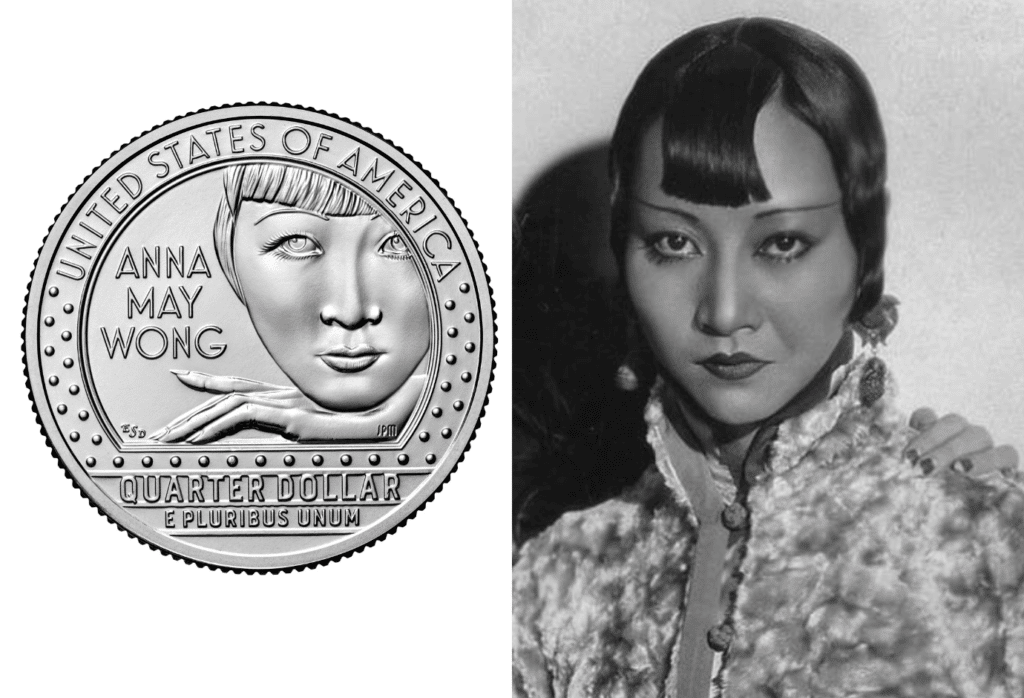One of Hollywood’s leading trailblazers, Anna May Wong, will appear on America’s quarter-dollar coin, becoming the first Asian American to appear on US currency.
Wong, who died in 1961 at the age of 56, is famously known for her prolific career in Hollywood during a time when racism and stereotypes of Asian women were rife.
Her image, featuring her signature blunt fringe and long fingernails, is part of the U.S. Mint’s American Women Quarters Program.
Mint designer Emily Damstra, who helped create the coin, said she tried to incorporate Wong’s personality into the design of the coin.
“Along with the hard work, determination and skill Anna May Wong brought to the profession of acting, I think it was her face and expressive gestures that really captivated movie audiences, so I included these elements,” she said.
“Many prominent actors from the 1920s and 1930s saw their name framed by lightbulbs on movie theatre marquees, so I thought it made sense to feature Anna May Wong in this way.”
Widely recognised as Hollywood’s first Asian American movie star, Wong acted in over sixty films between 1920-1960, including films such as “The Thief Of Bagdad” (1924), “Dinty” (1920) and “Shanghai Express.” (1932).
Director of U.S Mint, Ventris Gibson, said Wong was “a courageous advocate who championed for increased representation and more multi-dimensional roles for Asian American actors”.
“This quarter is designed to reflect the breadth and depth of accomplishments by Anna May Wong, who overcame challenges and obstacles she faced during her lifetime.”
Wong was born in 1905 in LA’s Chinatown to second-generation Chinese Americans. Her father ran a laundry shop, and she was one of seven children.
She received her first acting job at 14 in “The Red Lantern” before landing her first major role in Chester M. Franklin’s 1922 film, “The Toll of the Sea.”
Throughout her career, she endured persistent discrimination for being Asian — in her role as Hui Fei in Josef von Sternberg’s 1932 film “Shanghai Express” she received $US6,000, while her co-star, Marlene Dietrich, was paid $US78,166.
In the early twentieth century, Hollywood forbade onscreen interracial relationships, preventing Wong to ever get a role as a leading female actor. Anti-miscegenation laws across the country also forbade interracial marriage during that time.
When Wong was trying to work as an actor in Hollywood, The Chinese Exclusion Acts was still in place, and were not repealed until 1943. The law was the first significant legislation restricting immigration into the U.S, and inspired the unfair treatment of Chinese immigrants.
Wong was awarded a star on the Hollywood Walk of Fame in 1960, less than twelve months before her death.
Her coin is the fifth design of the American Women Quarters Program, highlighting female pioneers on US currency.
Beginning earlier this year, and continuing through to 2025, the U.S Mint will issue five quarters each year. “The ethnically, racially, and geographically diverse group of individuals honoured through this program reflects a wide range of accomplishments and fields, including suffrage, civil rights, abolition, government, humanities, science, space, and the arts,” an official statement from U.S mint said.
Previous designs this year have featured America’s first female astronaut Sally Ride, the first woman chief of the Cherokee Nation Wilma Mankiller, activist and poet Maya Angelou, and suffragist Nina Otero-Warren.
In January 2023, the Mint will print more honourees, including the first African-American woman Bessie Coleman, Hawaiian dancer Edith Kanakaʻole, American journalist Jovita Idar, ballerina Maria Tallchief and Eleanor Roosevelt.


